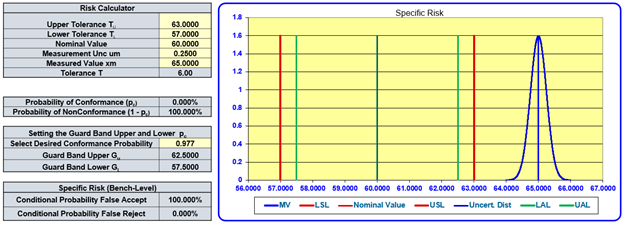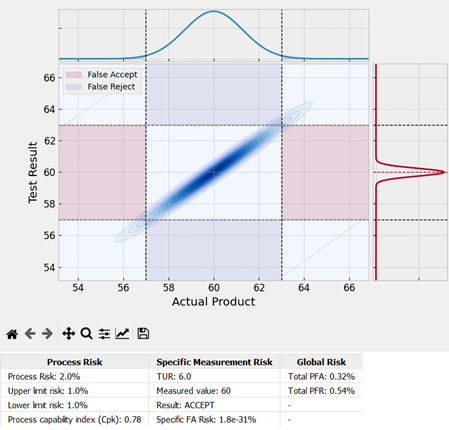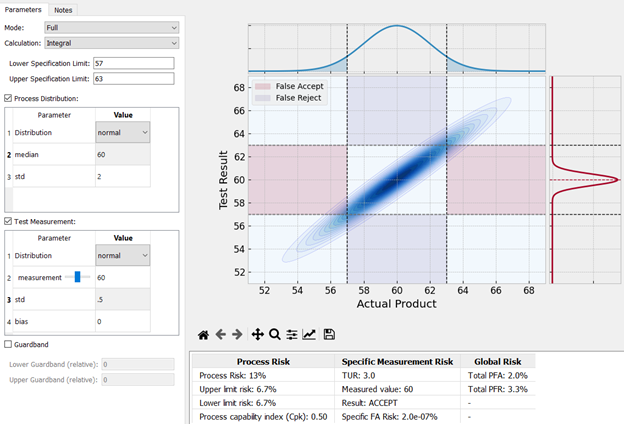A Simplified Global and Specific Risk Example
A company has hired us to measure the speed of cars on a stretch of a single-lane road.

The customer wants options using both Global and Specific Risk examples as they are unsure what method will give them what they need to meet the specification as they know many solutions exist and want the one that delivers the most bang for the buck.
Using a global risk model, we may base the speed on the car's time from point A to Point B (This would be the average speed for one mile of driving), while a specific risk model would measure the speed at one point.

Global and Specific risk example (Global Risk using the Average of Point A and Point B)The customer has indicated they are okay with 57 -63 miles per hour (MPH) speeds.
Thus our specification limit is based on 60 MPH ± 3 MPH.
The posted speed limit is 60 MPH.
After much discussion, we decided to set up two radar guns at points A and B for the first day and report the results.
The first car enters point A, traveling at 65 ± 0.5 mph, and then 0.5 miles into the drive, travels at 55 ± 0.5 mph.
The Calibration Process Uncertainty of this measurement is 0.5 MPH (TUR of 6:1).
On Day 1, we record about 10,000 vehicles. Out of the 10,000 vehicles, 9,800, or 98 %, are observed to be driving between 57 - 63 MPH.
There is very little doubt in our ability to accept the results.
The results are reported to the customer, who is pleased with the results and ask if there is a way to reduce the costs of paying for two people with radar guns is expensive.
Since the speed limit on the stretch of road is 60 MPH, we could also decide to use a time-based method.
Something like a stopwatch.
Using the stopwatch method, we take our first reading, and the stopwatch reads 1 minute.
Though this method comes with a higher calibration process uncertainty.
We determine we can measure 60 MPH ± 1 MPH. (A TUR of 3:1)
Global and Specific Risk Example (Specific Risk)
If we wanted to look at the car's speed using Specific Risk, we might look at the individual measurements at either Points A or B.

In this example, the car is clocked at 65 mph at point A, shown in the image above.
The measured value of 65 MPH is clearly outside of our tolerance limits and guard-banded acceptance limits.
There is a 100 % conditional probability of false acceptance.
This means there is no chance we could call this measurement good and have it be considered bad.
Note: Some may use Guarded Rejection to ensure there is zero probability that if a ticket is written, the person was not speeding.

If we measure 55 MPH at point B, that is also a Specific or Bench-Level risk.
Combining the measurements at points A and B gives us an average of 60 MPH (Global Risk).
Looking at either of these points individually is Specific Risk.
Each point is 5 MPH below or above the speed limit.
It is a different picture than if we use the stopwatch method, as the stopwatch only shows us the average speed for driving one mile.
That could equate to a car entering point A at 90 MPH and slowing to 30 MPH at the halfway point to average 60 MPH.
Note: This example may highlight an extreme, though each type of risk method has its place and will be discussed in greater detail in future articles.
Additional Information on Global Risk Using Suncal Software

Global Risk - According to our data found by combining the radar guns at point A and point B, about 1 % of drivers will drive over 63 MPH and 1 % below 57 MPH.

Global Risk – Using a less accurate means of measuring (A process with a higher measurement uncertainty, such as our stopwatch)
We may not know the specific speeds at points A and B, though we will know the average speed on the mile stretch of road.
This might be good enough for what we want to measure, as this scenario shows a higher unconditional probability of false acceptance (Total PFA).
A Simplified Global and Specific Risk Example – Conclusion
Specific risk is often thought of as controlling the quality of individual workpieces or examining the individual measured values on the test, measuring, and diagnostic equipment (TMDE).
In our example, it was measuring the car’s speed with a radar gun at point A or point B.
If someone were more risk-averse, they might decide bench-level or specific risk is the only method that might make sense for the measurements on their equipment.
The police officer measured your speed at a specific point in time, and there was no chance that their measurement was not correct.
They could issue you a ticket.
In contrast, global would then be controlling the average quality of workpieces or using an average based on a pool of similar TMDE using reliability targets using the same calibration intervals and TURs.
In our example, it measured the car’s speed with a radar gun at point A or point B and took the average or used a method based on averages, such as the time it takes to get from point A to point B.
Global Risk carries the additional risk of likely not knowing the individual speeds traveled on the mile-long stretch of road.
It might be good enough to be interested in population data and controlling the average speed or average of the measured values.
A police officer will not be able to ticket you based on using averages.
Thus, the difference between global and specific risk is based on your risk tolerance and what needs to be accomplished.
A global approach may be good enough if the application is less critical. It is ultimately up to the consumer or end-user on what risk tolerance makes sense for them.
If you enjoyed this content on specific and global risk, check out our LinkedIn and YouTube channel for more helpful posts and videos, some might have a global and specific risk example or two.
We also have several other articles relating to global and specific risk found here.
Everything we do, we believe in changing how people think about force and torque calibration. We challenge the "just calibrate it" mentality by educating our customers on what matters, educating on specific and global risk, so that they may understand the differences between the two.
Morehouse makes simple-to-use calibration products. We build fantastic force equipment that is plumb, level, square, and rigid and provide unparalleled calibration service with less than two-week lead times.
Contact us at 717-843-0081 to speak to a live person or email for more information.
Hopefully, our Global and Specific risk example has clearly distinguished the two risk types.
A Simplified Global and Specific Risk Example References
- ASME B89.7.4.1-2005 Measurement Uncertainty and Conformance Testing: Risk Analysis
- Suncal – Suncal is a free software offered by Sandia. It can be downloaded here.
#Global and Specific Risk Example


